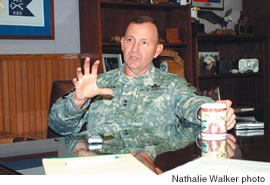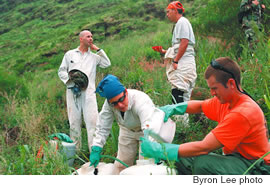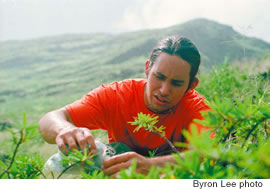Live Fire And Living Treasures
Hawaiian environmental experts and the Army work together in Makua Valley to protect 45 native species on the threatened/endangered lists and 119 archaeological sites. While live training is a threat, those experts worry what happens to the valley when the Army leaves

By .(JavaScript must be enabled to view this email address)
E-mail this story | Print this page | Archive | RSS

Maj. Gen. Mixon: ‘I was impressed with the state of
the valley’
One look into Makua Valley and it’s easy to understand the passion the area arouses. The steep green walls of the valley, the tall grass, rolling hills and proximity to the ocean make it a special place for not only Hawaii residents concerned with the area’s cultural and natural importance, but for the U.S. Army that finds it a necessary location for the training of its soldiers.
The importance of the area and the feelings of those who look to protect it are not lost on the man charged with balancing the delicate job of training his men for an increasingly unpopular war and being a good member of the community.
“My first impression is that obviously it’s a beautiful place,” says Maj. Gen. Benjamin Mixon, commander of 25th Infantry Division and U.S. Army Hawaii. “The valley, both from the perspective of looking up into the valley and also when you get to the very heights of the valley and you look back toward the Waianae coast, it’s a magnificent sight.
“At the same time, being involved in Army training for all of my career, I was impressed with the state of the valley and how the environmental programs have done out there, and the cultural programs have really taken into the maximum consideration in training and still protect the environment and protect the culture.”


Steve Mosher, Leanne Obra, Dan Forman and Seth
Cato prepare to spray for weeds that threaten native
species (top), and then head out
As part of the Army’s lease with the state over use of the valley, the Army is required to maintain the area’s cultural and environmental sites. The area must also be open to civilian groups who wish to use the valley for cultural purposes.
“We work around Makahiki,” says Sparky Rodriques, the president of Malama Makua, a cultural and environmental group working to protect the valley. “It’s a traditional time of peace, following the harvest season and to honor Lono (the Hawaiian god of fertility).”
In collaboration with the University of Hawaii Research Corporation, through which the 22 environmental workers are contracted, the Army spends approximately $1 million a year on programs that stretch from keeping out unwanted animals to propagating seeds for rare indigenous plants. David Henkin, a lawyer for Earthjustice, said the valley is home to 45 federally listed animal and plant species that are either threatened or endangered and more than 119 archaeological sites.
“One of the first big problems were goats. It took 10 years to eradicate them and to put fences put up to keep animals out,” says Matthew Burt, the natural resource coordinator.
Burt says the focus of the work had been established a decade ago by the Makua Implementation Plan, which brought together scientists and cultural experts from the U.S. Army, the Nature Conservancy of Hawaii, the University of Hawaii, the U.S. Fish and Wildlife Service and others, to design a plan of attack for the area.
“Our job is really just to read the cookbook and apply all this knowledge,” Burt says.
The job isn’t easy. Though from a distance the valley seems to be a pocket of lush greenery, the lower areas are filled with hard brush and tall grass that excels on the hot floor. Workers hike along the steep sides toting containers heavy with weed killer to eliminate nonnative species that threaten indigenous plants. Another big job is repopulating the valley and other sites along the Koolau mountain range. This is done by carefully putting plastic bags over the seed pods so that when they are fully developed they can be easily gathered with no waste and then taken to designated sites. And when hiking and climbing can’t get them close enough to their targets, it’s time to go over the side. Yes, rappelling over sheer rock face is part of the job. Every person who works in the valley is taught and certified for the rope work to ensure safety.

Kaleo Wong checks a native plant high above the
valley floor
“If you don’t like heights, if you don’t like hard work or you don’t like nature, this is not the job for you,” says Burt. Fortunately for the area, the workers love what they do.
But no matter how much time and money is spent in the valley, it’s an issue that still causes much anxiety - even for those closest to the action. How does an area that is seen as crucial to such different roles find a balance so that everyone is happy? Is it even possible?
“The cultural significance of Makua Valley is polarizing,” says Mixon. “These issues are very important. I understand that. I became familiar with similar issues when I was in charge of the training lands at Fort Campbell, Ky. Fort Campbell, Ky., is one of those areas in World War II where the Army bought a lot of land, a lot of farm land. All this farm land was burial sites, family burial sites for the people who farmed it. We were obligated by law to protect those burial sites, and families would come back in and go to those burials sites. So it’s kind of the same issue. These are important historical sites, so it’s hard for us as a military to make people who are concerned with these things to be comfortable with the fact that we will do everything we can to protect these cultural sites, and that causes things to be polarized. It’s not that
Page 1 of 2 pages for this story 1 2 >
E-mail this story | Print this page | Comments (0) | Archive | RSS
Most Recent Comment(s):








